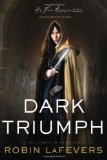
 Dark Triumph
Dark TriumphHis Fair Assassin, Book II
Reviewed May 2, 2013.
Houghton Mifflin, 2013. 387 pages.
Starred Review
2013 Sonderbooks Stand-out: #3 Teen Fiction
2013 Cybils Finalist
When this book came in, it gave me the obvious excuse to reread Grave Mercy, which I loved as much the second time, appreciating some of the intricacies of the plot even more this time around. The second book, Dark Triumph, contained yet more detailed history you never knew and sinister political intrigue of medieval Brittany, with the same light touch of mystical gifts from the god of Death himself.
I do recommend reading these books in order. Technically, you could follow this book without reading the first, but you understand the political situation much better having read the first book, and it's much easier to keep the characters straight. Once you've read the first one, it's hard for me to imagine not wanting to read the second.
In Dark Triumph we find out what Sybella, the second novice from the convent devoted to Saint Mortain has been doing. Like Ismae, she's been trained as an assassin, but her assignment is even more difficult than Ismae's, as Sybella has to infiltrate a place where evil reigns. We learn more about Sybella's background, which drove her to the edge of madness.
I don't want to say a lot about the plot. It's set in 15th Century medieval Brittany, with a young duchess who needs to form an alliance to hold back the French prowling on her borders. The main events are based on actual historical events I knew nothing about -- with the insertion of the Daughters of Death going out to do political assassinations. The second book wasn't quite as heavy on the political intrigue, but there was plenty of action and psychological intrigue to keep the reader anxious.
I love how Robin LaFevers puts it on her website, talking about Anne of Brittany, an actual historical figure:
Her substantial inheritance was complicated by two things. One, she was a woman at a time when traditionally women did not inherit kingdoms. Since the time of Charlemagne, Salic Law had been invoked to prevent women from becoming rulers. When Anne became Duchess of Brittany, it defied all the conventions of that time. Secondly, and perhaps more importantly, not only was she unmarried, but her father had promised her hand in marriage to at least half a dozen European nobles, if not more. As he plotted and strategized, trying to keep his lands and title safe from the French Crown, he dangled his daughter (and her substantial dowry) as bait for the aid he needed from other princes and dukes. Consequently, when he died, she had been promised to more than one suitor.
To say that this created problems for her in keeping her duchy independent is an understatement. Which is why she needed the help of assassin nuns. What? Doesn’t everybody call for assassin nuns when they’re having political difficulty? If not, they should….
There's romance in this book, just as in the first one. But the romance is a wholly different story, fitting with Sybella's wholly different character. The two girls' gifts from Death are different as well. The author builds character beautifully, as they act and think and love consistently with who she's shown us they are inside.
The romance in this book is beautiful. Sybella's deeply damaged, so we're not surprised when she doesn't easily trust love. But she's still a strong character, able to easily kill a man. The man she falls in love with has his own amazing strengths, and they fit to help Sybella exactly where she's damaged. We can believe in their love, and I found myself fully happy for Sybella. Yes.
I also loved the scene in both books where each girl meets Saint Mortain, their father, Death himself. I love his portrayal, not as a god who demands their dutiful, exacting service, but as a father who loves them no matter what. I didn't expect to find such a beautiful portrayal of God in a description of the god of Death. I love the way each girl comes to understand and serve a different aspect of Death, even realizing he's the same god.
It's also well done in each book how the girls come to understand the gifts they have as Death's daughters and how that doesn't necessarily fit what they were taught at the convent.
There's some ugliness in this book. Sybella's past isn't pretty, and she's been sent to an evil place. But the story is rich and deep and I'm so glad at least one more book is promised, telling about the third fair assassin from the convent of Saint Mortain.
This series is another example of books written in present tense that I loved anyway. I noticed the present tense (in a negative way) occasionally, but only very rarely. The gripping story far outweighed that little annoyance, and I might grudgingly be convinced this was the best way to tell the tale. I am already certain this book, like its predecessor, will be a Sonderbooks Stand-out.
Here's how the book begins:
I did not arrive at the convent of Saint Mortain some green stripling. By the time I was sent there, my death count numbered three, and I had had two lovers besides. Even so, there were some things they were able to teach me: Sister Serafina, the art of poison; Sister Thornine, how to wield a blade; and Sister Arnette, where best to strike with it, laying out all the vulnerable points on a man's body like an astronomer charting the stars.
If only they had taught me how to watch innocents die as well as they taught me how to kill, I would be far better prepared for this nightmare into which I've been thrust.
